Back to Sidestreet Bannerworks
Click here to find out how your engine can be featured!
.

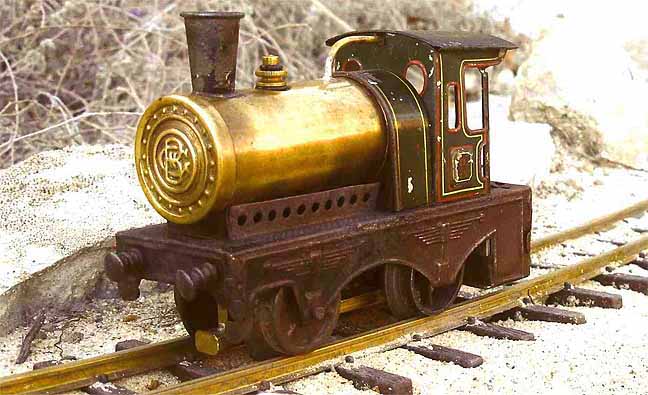
A simple Bing 0-4-0T, c. 1904
by Grant Fehr
Peyton Colony, Texas
Photos by the author
February, 2012
In the golden age of toy-steam railroading, the principal claim to single-cylinder locos belonged to Gebrüder Bing of Nürnberg (GBN). The earliest had a vertical cylinder in the cab, made in gauges 0 and 1, and, by 1902, both Bassett-Lowke and Gamage's (the London department store) catalogued a very small gauge-0 tank loco by GBN, with a vertical cylinder and a thumbwheel “starter” projecting from the side. At 6-in. long, it was a precursor to the model featured here, and to later diminutive Bing steam locos, except that their solo cylinders oscillated horizontally.
Bing later offered these single horizontal-cylinder toys (I call them SHCs) in several 0-4-0 variants, all in gauge “No. 0.” Early on, there were two proper locos, with open-backed cabs and hinged aprons, usually sold with tenders. A Midland Railway loco in crimson lake, included here for reference, represents the smaller of those two variants. It dates from around 1910.
There was also a longer-chassis “express” version, which Gamage's shows as early as 1906. This was offered in a choice of Midland or L&NWR liveries and was certainly the most expensive at three shillings eleven. But that was less than half the price of a bare-bones Carette or Bing gauge 0 “stork leg,” with twin oscillating cylinders mounted in the conventional places.
Even cheaper by half was another early Bing SHC, something of a “tank loco” in that it had no tender but a very long bunker hanging out at the rear, perhaps a cut-rate attempt at a stylized loco-cum-tender. In 1906, Gamage's sold this (in the same choice of liveries) for one shilling eleven pence plus three pence postage -- maybe twelve bucks in today's money. That got you an absolute minimum-but-functional live-steam loco.
Presumably these cheap little SHCs were good sellers, especially the long-bunker versions, because Bing made them from the very early 1900s well up into the '20s, and possibly until its demise in 1932. Yet they are not that common today and those that do appear for sale tend to be of post-WWI vintage.
The engine at hand
For a couple of reasons I think this particular example is quite an early Bing SHC, probably 1903-1905. One is the finish on the cab -- it's mostly paint rather than lithography, and at least some was applied by hand. Also, because it was probably originally sold in Britain (I bought it at a UK live auction), the next clue is the tall, tapered chimney.
This, of course, is typical of a German-outline loco from the late 1900s, viz. Krauss's little 0-4-0s on the Lokalbahnen around Nürnberg. But for Britain, the voracious tastemaker in all things steam, such a chimney was not only quaint but emphatically “not British.” So, whereas in 1902 Bing's vertical-cylinder tank loco also had a tall chimney like this one, from at least 1906 on, stubby chimneys (such as on the MR loco above) are what most Bing SHC models had in all of Bing's markets.
This model is also unusual in that it has a true tank -loco profile. There is no apron (nor any place to attach a missing one) and there are four slots around the back of the frame where a short “bunker” would have been tabbed on. As it is, I prefer the hotrod look.
Otherwise, this engine is like later models. Its frame is the same stamping as that of its later MR cousin. If it appears shorter, that's because the cab is mounted further forward behind a much narrower “saddle tank” or cowl.
It also has the same guts. It came to me without its original piston, connecting rod, cylinder and block. Yet these parts, when filched from a mid-1920s long-bunker SHC loco, fitted straight onto the port block. With some slight changes and improvements, Bing had stuck to the original design for a good twenty years. The (filched) piston is a whopping 6mm. in diameter (1/4”), with a leather band around the middle to improve the seal. The (also filched) stamped-steel connecting rod drives an offset pin on a six-spoke horizontal lead flywheel, laid like a drive wheel on its side. A pinion gear on the flywheel shaft engages a crown gear on the axle. The drive wheels are cast and turned from a lead alloy.
The entire works -- from cylinder down to axle -- is mounted to a discrete rigid frame of stamped steel, which also serves as the “footplate,” and is fixed to the chassis by four tabs. Such a compact, integral mechanism attached to a lightweight tinplate frame, usual in clockwork toys of that era, is a departure from most toy-steam locos.
The boiler is very thin sheet brass. The chassis itself is thin-gauge tinplate (as are the front wheels) and thus part of the bodywork. Unlike other live-steam locos of the same vintage, there is nary a machine screw in the whole contraption. The only threaded parts are the spring-loaded pins holding down the safety-valve cap and cylinder block, along with the safety-valve body with its collet. The rest is held together with tabs and a bit of solder as needed, like any tinplate toy.
The steam line into the cab (another Krauss motif) doubles as the steam dome and thus does not run warm and snug down the side of the boiler. In later SHCs it descended through the floor (where it got a reinforcing daub of solder) and back up to the port block. In this case, it simply curls across the floor, another indicator that this example may be very early in the series. In post-WWI models, there is usually a short pipe off the back of the port block supporting a small oiler cup -- a useful improvement. Exhaust steam is ported straight down, which possibly elevates the fuel pressure but mostly assures the fuel tank a good hot shower.
Repairs and running
Because of the tabbed construction, tearing one of these down is a high-stress adventure. But the overall condition here didn't warrant that.
I cleaned up what I could (in particular the embossed logo), but the first firing revealed a leak in the boiler seam, which meant removing and re-soldering the backhead cap.
The burner assembly was also missing when I received the engine. I was hoping I could share the MR's. But the burner tube exits the tank at a slight offset to clear the crown gear. And whereas the MR's crown gear is on one side of its pinion, this one is on the other. So I slapped together a new assembly in hopes I can find an original someday. The wicks could use a trim.
I have seen two late SHC examples with no safety valve, merely a filler cap screwed into an undersized collet. I cannot say for certain that this is original, but if the cylinder block sits on the port block and is pinned down by a compression spring, then a separate safety valve, having the same arrangement of parts, does seem somewhat redundant. So I use two neoprene O-rings on the valve and wait for the cylinder block to jump and fizzle like a safety-valve cap before I push off. A little hotrodding can go a long way.
A run on my fledgling railway can be seen in the video below. If you can't see it, click here.) The coaches are later Bing and possibly from a “de luxe” George V clockwork set.
If you watch the video you will see that SHCs don't exactly “run,” they bustle. Even so, whilst fussing around my loop, this one ticked close to 600 meters after 12 minutes of fuel.
Footnote: Bowman Model's elusive No. 410 was the only real imitator of the Bing SHC design, and a very fair copy of the “long bunker” model. No doubt Bowman's focus on cheap and rock-steady performance in lieu of meticulous or even token realism found a kindred spirit in these little Bings. They are unpretentious toys for toys' sake, and well worth it for that alone.
|
|
|
| Builder | Gebrüder Bing (Nürnberg, Bavaria) |
| Date completed | Circa 1904 |
| Gauge | 0 (32mm) |
| Boiler | Pot with 50 ml. capacity (40 ml. for a good head of steam) |
| Tank capacity | 17 ml. (including burner tubes) |
| Fittings | Safety valve |
| Fuel | Alcohol |
| Cylinders | One oscillating horizontally & driving horizontal flywheel |
| Power transfer | Pinion and crown gear |
| Reversing gear | None |
| Lubricator | None |
| Dimensions | Length, 164 mm; width, 50 mm; height, 100 mm |
| Weight (dry) | 9.5 oz. |

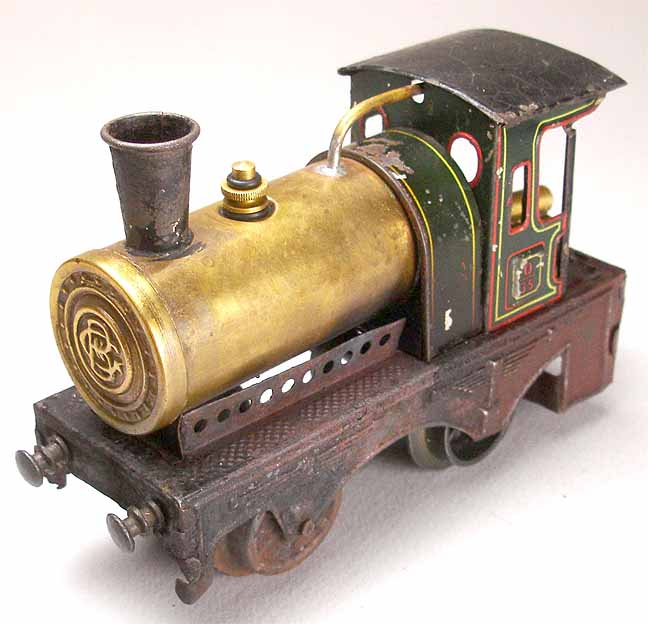

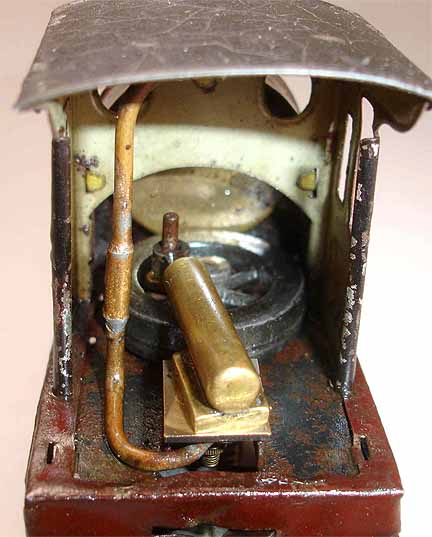

Below: The cab side. The "0" indicates 0-gauge. The "35" is the gauge in millimeters. In those days, gauge was measured to the center of the rail, not the inside edge, hence "35" instead of "32."
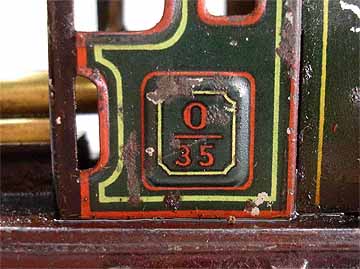



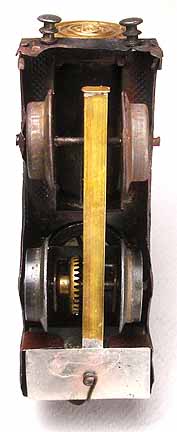
Right: The underside. The author's new burner, with its slightly offset feed tube, is in place.

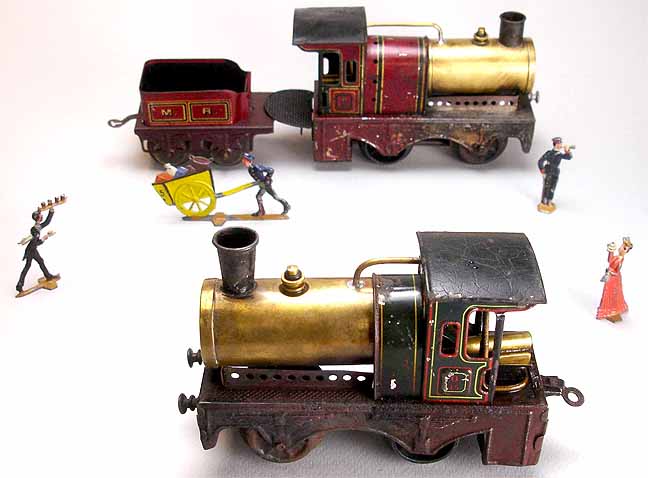
Back to Sidestreet Bannerworks
Click here to find out how your engine can be featured!
This page and its contents
Copyright Sidestreet Bannerworks, 2012